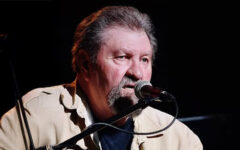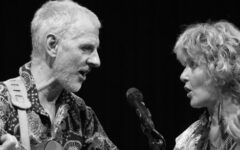
France’s Bluegrass 43 possess a lengthy history that’s made them one of Europe’s most accomplished bluegrass ensembles. The band, which currently consists of Philippe Ochin on mandolin and lead vocals, Alain Audras on upright bass, bass vocals and occasional reso-guitar, banjo player and tenor vocalist Jean-Marc Delon, guitarist and baritone singer Jean-Paul Delon, and fiddler and vocalist Anna Takayasu, originally came together in 1975 when the Delon Brothers embarked as a guitar duo, fingerpicking in the style of Merle Travis, Chet Atkins, and French guitarist Marcel Dadi.
In 1976, Jean-Marc switched to 5-string banjo, and a year later, they hired a mandolin player, Alain Piette, and named their trio Bluegrass 43 after the number of their home “department.” (France is divided into 100 departments, Jean-Marc explains.) “It was also a reference to the Japanese band Bluegrass 45, he adds dutifully. In 1980, the group then hired an Audras on upright bass, and in 1983 they brought Ochin in on lead vocals and mandolin, following the departure of their previous mandolin player.
“Funnily enough, Alain and I had met Philippe in 1981 at the Kentucky Fried Chicken Bluegrass Festival in Louisville, KY,” Jean-Marc notes.
Early on in their trajectory, Francis ‘Bob’ Vital served as the fifth member of the band, playing harmonica and singing some lead and tenor vocals, but this year, Japan’s Takayasu joined the group.
Personnel changes aside, Bluegrass 43 is currently considered France’s oldest touring band specializing in bluegrass, Jean-Marc insists. “It’s a ‘family and friends’ band, which explains the longevity.”
He goes on to describe their sound as, “Traditional bluegrass with a modern twist. In the ’70s and ’80s, we used to adapt a few numbers from the French repertoire — or from the classic music repertoire — but then we focused more on ‘regular’ bluegrass, both traditional and contemporary. We also added some songs from country music (Hank Williams, The Mavericks, etc) and from American songwriters (Darrell Scott, Kate Wolf, Hugh Moffat, etc.).”
Delon lists such seminal influences as Bill Monroe, Flatt & Scruggs, Doc Watson, J.D. Crowe, Tony Rice, David Grisman, Seldom Scene, New Grass Revival, and The Osborne Brothers.
Not surprisingly, Bluegrass 43 have played literally hundreds of gigs throughout France and the rest of Europe. In addition, they’ve tallied five summer tours of the US in the ’80s and ’90s, a 1983 win at France’s Toulouse Bluegrass Festival, and Jean-Marc’s top ranking for banjo at the Kerrville Bluegrass Festival in 1981.
Indeed, their list of festival appearances is impressive. In addition to those events mentioned above, they’ve played Kentucky’s McLain Family Bluegrass Festival, the Milan Bluegrass Festival, France’s Country Rendez Vous Festival and La Roche Bluegrass Festival, the Paleo Folk Festival in Switzerland, Germany’s Bühl Bluegrass Festival, Belgium’s Picnic Festival, Ireland’s Westport Folk & Bluegrass Festival, and the Station Inn in Nashville — the latter, three times.
“We shared the stage with many great artists, among them, Bill Monroe, Ralph Stanley and the Clinch Mountain Boys, The Osborne Brothers, Hot Rize, New Grass Revival, Doyle Lawson & Quicksilver, The Whites, The Johnson Mountain Boys, Larry Sparks, Jimmy Martin, and Jim and Jesse,” Jean-Marc says. “We played a few gigs as the backing band for guitarist Kathy Chiavola and fiddler Randy Howard in France in the ’90s, and also performed alongside Kathy in Belgium in the 2000s. We had Sam Bush as guest for our set at the 1984 Toulouse Bluegrass Festival, and played a few songs with Buck White at the Kerrville Bluegrass Festival in 1982.”
While Bluegrass 43 has clearly mingled with any number of acclaimed contemporaries, they’ve also scored well on their own. Jean-Marc says they’ve been embraced back home, and that appreciation has continued to flourish throughout their career. “They generally like our music since we try our best to be close to the audience by adding a little bit of humor in every concert,” he says. “Sometimes we use a Telecaster instead of the banjo, and play some Hank Williams songs. In the ’80s we even used a lap steel, playing a few western swing numbers.”
To date, the group has released three offerings — their first LP The Old,Old Truck in 1985, the, Country & Swing in 1988, recorded in Nashville in 1988 with guests Sam Bush on fiddle, Kenny Malone on drums, and Kathy Chiavola on backing vocals, and the 2011 EP titled The Witch, featuring Stuart Duncan on fiddle.
“We play mostly covers, but try to be original with our arrangements,” Jean-Marc continues. “We choose traditional material by Bill Monroe, Flatt & Scruggs, and the Stanley Brothers, among others, as well as more contemporary songs from The Beatles, Darrell Scott, The Mavericks, and Gillian Welch.”
Asked to explain the popularity of bluegrass, especially in their country, Jean-Marc provides a thoughtful explanation. “There is a paradox in France,” he maintains. “The American bluegrass musicians who come over and play in France think this genre is popular here because they receive a warm welcome from an audience of aficionados — and even from a general audience in a big festival like La Roche Bluegrass — but almost no-one has heard bluegrass music on radio or TV. And you can count on the fingers of one hand the number of French professional bluegrass musicians. As we like to say ‘French people don’t like bluegrass music, until they hear it!'”
Consequently, Jean-Marc describes bluegrass as a niche, mostly confined to the musicians that play it themselves. “There are quite a few regular jam sessions going on in several parts of the country,” he maintains. “Paris and Lyon come to mind, but many other places host jam sessions as well. We have two main gatherings — the La Roche Bluegrass Festival in La Roche sur Foron in August and the Winter Bluegrass Festival in Vichy in November, which is where most of the French bluegrass musicians come together to jam and to hear bands from the USA or Europe. What makes bluegrass enjoyable here, to those few people who get a chance to hear it, is the energetic and lively feel of the music. It’s an acoustic music made by the people for the people.”







